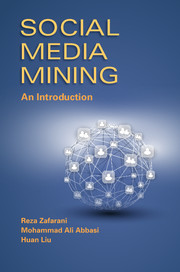8 - Influence and Homophily
from Part III - Applications
Published online by Cambridge University Press: 05 July 2014
Summary
Social forces connect individuals in different ways. When individuals get connected, one can observe distinguishable patterns in their connectivity networks. One such pattern is assortativity, also known as social similarity. In networks with assortativity, similar nodes are connected to one another more often than dissimilar nodes. For instance, in social networks, a high similarity between friends is observed. This similarity is exhibited by similar behavior, similar interests, similar activities, and shared attributes such as language, among others. In other words, friendship networks are assortative. Investigating assortativity patterns that individuals exhibit on social media helps one better understand user interactions. Assortativity is the most commonly observed pattern among linked individuals. This chapter discusses assortativity along with principal factors that result in assortative networks.
Many social forces induce assortative networks. Three common forces are influence, homophily, and confounding. Influence is the process by which an individual (the influential) affects another individual such that the influenced individual becomes more similar to the influential figure. Homophily is observed in already similar individuals. It is realized when similar individuals become friends due to their high similarity. Confounding is the environment's effect on making individuals similar. For instance, individuals who live in Russia speak Russian fluently because of the environment and are therefore similar in language. The confounding force is an external factor that is independent of inter-individual interactions and is therefore not discussed further.
- Type
- Chapter
- Information
- Social Media MiningAn Introduction, pp. 217 - 244Publisher: Cambridge University PressPrint publication year: 2014



